- Marschweg 95, 26131 Oldenburg
- info@bvise.de
Menu
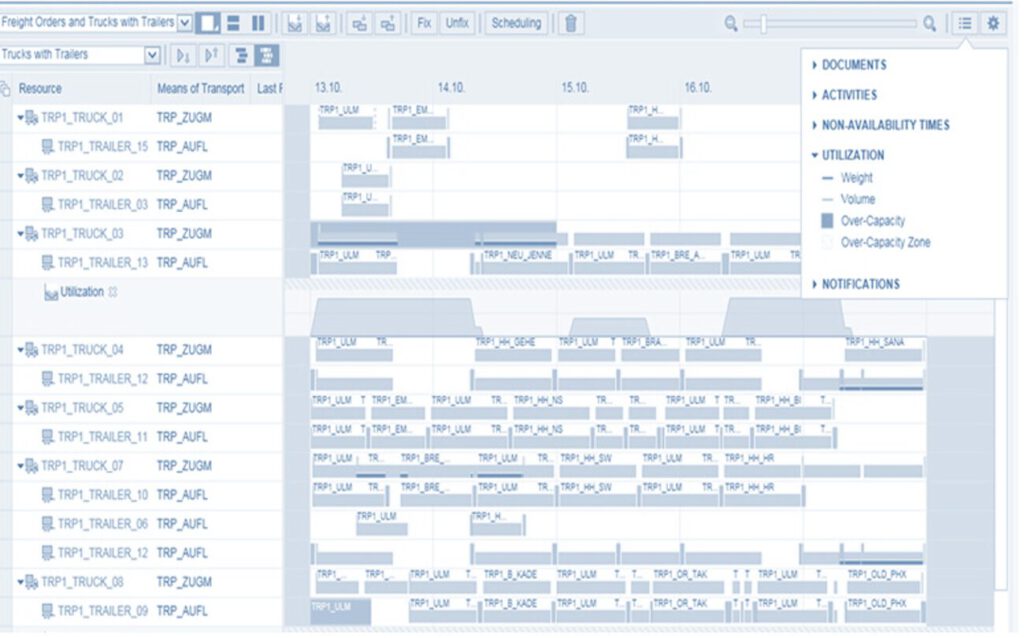
In today’s world, efficient transportation management plays a crucial role in a company’s success. SAP Transportation Management (SAP TM) is an all-in-one solution that helps your company optimize transportation processes, reduce costs and increase customer satisfaction. In this article, we will go through some of the different planning options offered by SAP TM and explain them for you.
The aim of the integration is to automatically provide materials directly from the warehouse. Inventory management is efficient and all processes are automated. Only a few manual interventions are necessary. Service orders are seamlessly synchronized and managed in real time.
The SAP TM planning processes are triggered by customer orders, purchase orders or deliveries, among other things. Creating one of these documents generates the so-called freight unit in SAP TM, which is the smallest, plannable business document and physically represents the goods to be transported.
These freight units are planned in a freight order for road and rail transports and in a freight booking for sea or air transports. The freight order contains all the information about the planned transportation and can be physically represented as the loaded truck. The freight booking in turn represents a container space booking on a cargo ship or a cargo space booking in an airplane.
The central interface of SAP TM, the heart of the system, is the so-called Transport Cockpit, in which the entire planning process can be carried out. The Transport Cockpit is highly customizable and has various customizing options to optimize the user experience and make day-to-day business tasks as pleasant and efficient as possible.
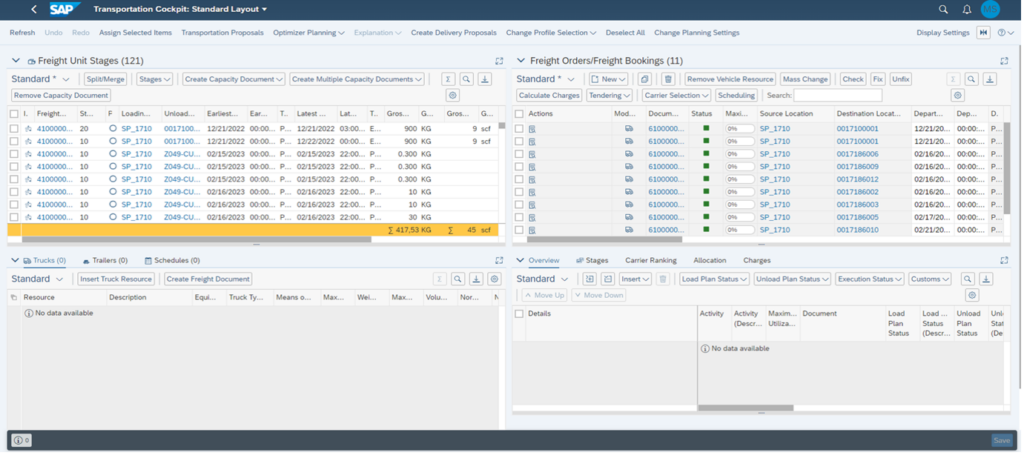
Some of the tasks within the transportation cockpit include
The planning activities can be carried out manually, automatically, interactively or in the background.
SAP S/4HANA Transportation Management is divided into two licenses. On the one hand, we have the Basic Shipping Model, which is already integrated in the S/4HANA license, and the Advanced Shipping Model, for which an additional license is required. We will go into some of the content and differences here. However, these are not yet all. Please contact us for more information!
Manual planning
Manual planning consists of two variants:
In the transportation cockpit, select the requirements documents to be planned, e.g. freight units and the respective requirements capacity, e.g. vehicle resources. The capacity document, e.g. a freight order, is created using the “Assign selected elements” button.
Creation via drag & drop: Here, the respective requirement document is dragged onto the requirement capacity, or vice versa, and the freight order is generated.
It is also possible to create an empty capacity document from the transport cockpit, which can be planned with freight units at a later date.
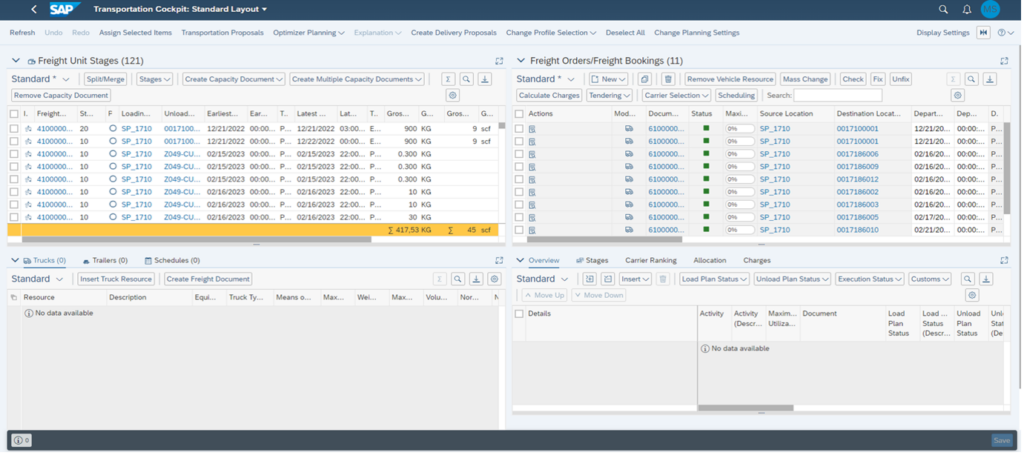
Various planning strategies can be defined for manual planning in Customizing for the transport cockpit. These define which steps are to take place during the planning process.
The map planning
Planning on the map can be activated from the transport cockpit. The map shows all unplanned freight units and vehicle resources. These can be assigned to each other using drag & drop and thus trigger the creation of the freight order.
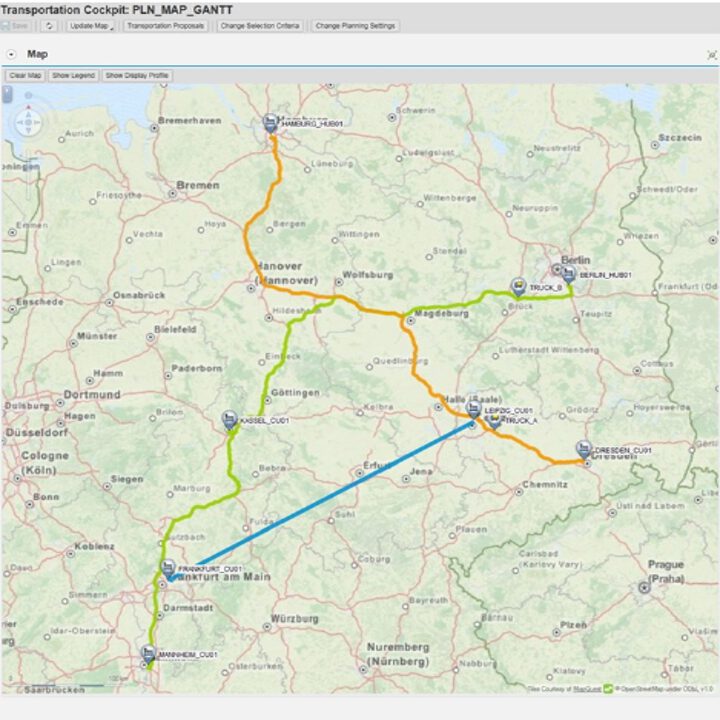
Gantt chart
Gantt charts are often used in project planning. They help to visualize resources and the transport sequence. Like map planning, the Gantt chart is fully integrated into the transport cockpit.
The freight orders and resources are displayed here as time bars and the transports can also be planned manually using drag & drop.
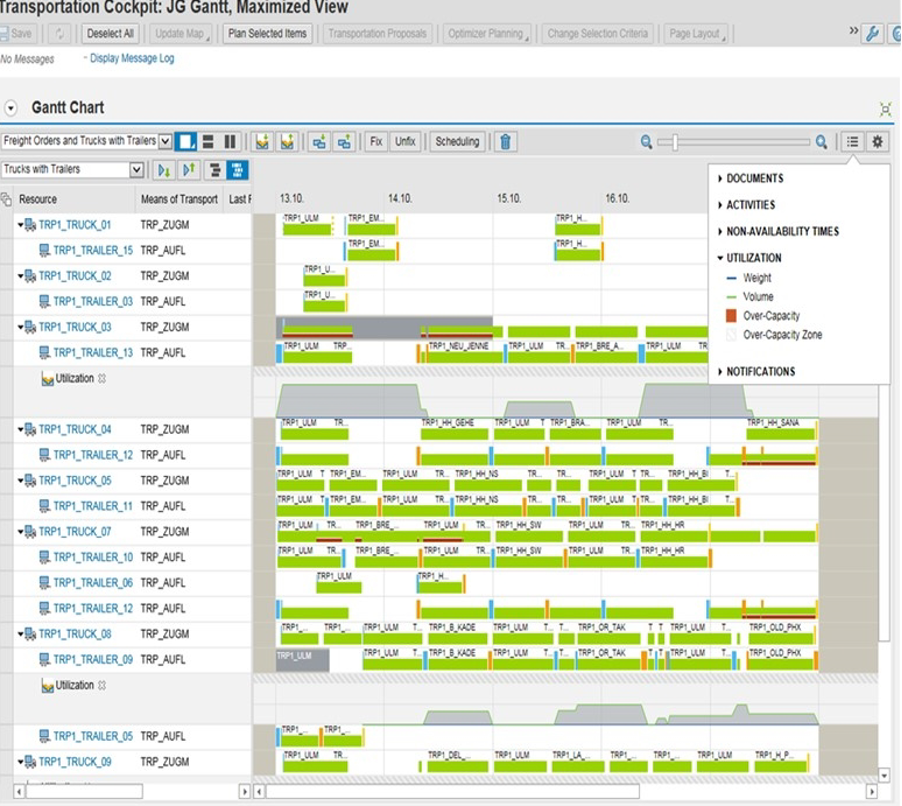
Automatic planning: VSR Optimizer
The Vehicle Scheduling and Routing Optimizer takes into account the routing and the order in which resources arrive at specific locations. The optimizer evaluates possible route changes and the effects of these changes on transport planning, thus helping to avoid delivery delays and subsequent costs.
The aim of the optimizations is to assign the freight units to the vehicle resources, to determine the route and sequence of the transport units per vehicle resource in such a way that all conditions are met and the total costs are minimized. The optimizer achieves this through a population-based meta-heuristic that uses selection principles from various algorithms.
The VSR optimizer uses the freight units and capacities to create a transport plan from freight orders.
Existing freight orders from a previous optimization run or from manual planning are also processed. Once the transport plan has been completed for the time being, it is modified step by step by rescheduling freight units to a different resource or adjusting the delivery sequence again.
Transportation proposals
The VSR optimizer generates alternative transport proposals for a freight unit using the “Generate transportation proposals” function.
The transportation proposals offer a good option for transparently displaying further transportation options outside the optimizer run.
Shortcut planning
With shortcut planning, the freight order is automatically created without a freight unit. These are skipped. In the previous planning variants, after creating a sales order, purchase order or stock transfer order, a freight unit is created in TM, which we use to plan our freight order. This step is skipped and a freight order is created immediately.
The purpose of the shortcut process is to be able to skip all planning steps, as these are not required in certain scenarios.
For example, if we already receive all the information we need for the transport from a sales order, we can deactivate the creation of a freight unit and consideration of a freight unit type in Customizing and instead store a freight order type, which creates the freight order immediately.
Modulares System oder als eigenständige Lösung
limitierte Funktionen zur Bestandsführung
keine Echtzeit Synchronisation zwischen Serviceaufträgen und Lagerbestand. Buchung des Materialverbrauchs oft erst nachträglich
Aufträge manuell oder auf Basis von Reservierungen oder separaten Buchungen
Embedded oder dezentrale Lösung
Klassische Lösung
Intelligente Serviceauftragsintegration
SAP S/4HANA Transportation Management can ideally map both complex and simple transportation scenarios. Without competent support, however, this can quickly become a mammoth task.
With our many years of expertise, we are happy to assist you with this task. Our consultants have been involved since the first release of SAP TM and can provide you with optimal support. Get in touch for a non-binding consultation!